Table of contents
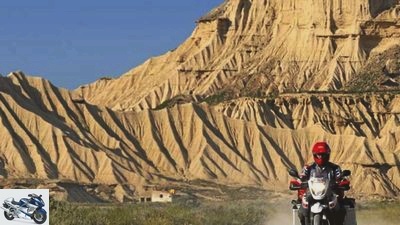
Deleker
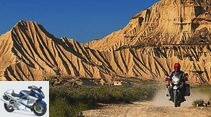
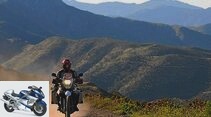
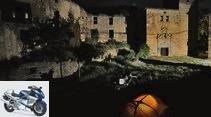
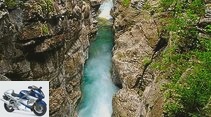
14th pictures
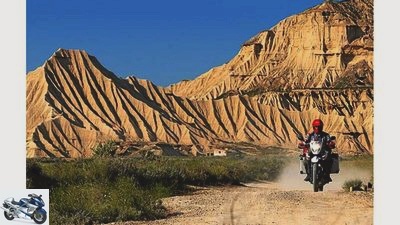
Deleker
1/14
Once across: exploring the French and Spanish Pyrenees.
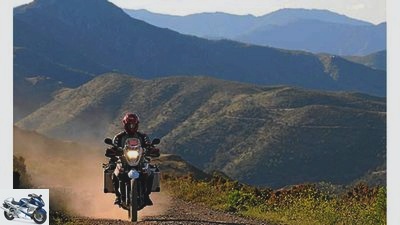
Deleker
2/14
Explore the Pyrenees adventurously on gravel roads.
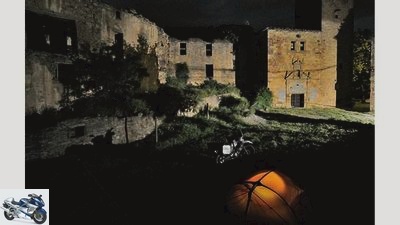
Deleker
3/14
Mysterious camp in front of the ruins of the village of Ruesta.
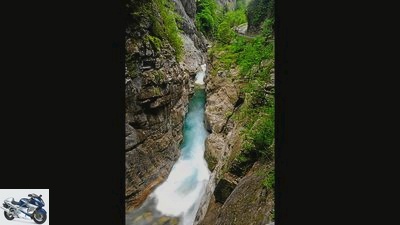
Deleker
4/14
The Desfiladero de Vellos is one of the most beautiful gorges.
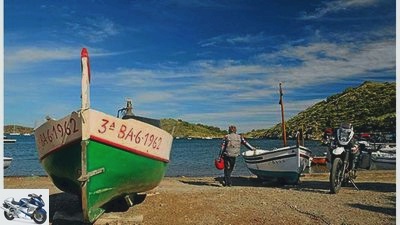
Deleker
5/14
Done: On the Mediterranean at Port Lligat, the fishing boats are waiting for their next mission.
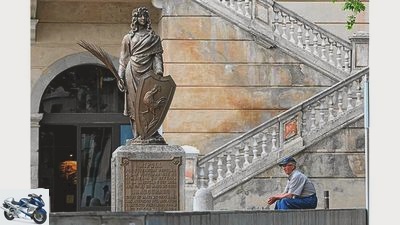
Deleker
6/14
The elderly Catalan has said goodbye to the hustle and bustle of everyday life.
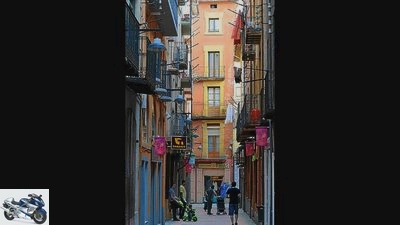
Deleker
7/14
The tranquil town of Ripoll has almost 11,000 inhabitants, is located in the Catalan pre-Pyrenees and has a monastery church that was modeled on St. Peter’s Basilica in Rome.
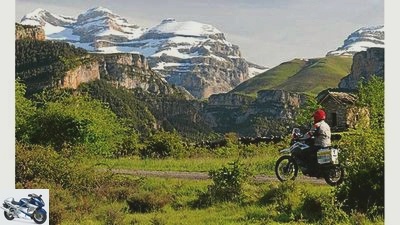
Deleker
8/14
A small path leads far above the Añisclo Gorge over a plateau and offers the best view of the three peaks of Monte Perdido (3355 meters).
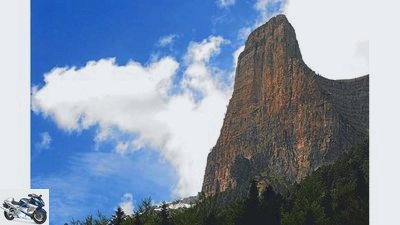
Deleker
9/14
Fantastic red and yellow rock towers, vertical, huge, bizarre.
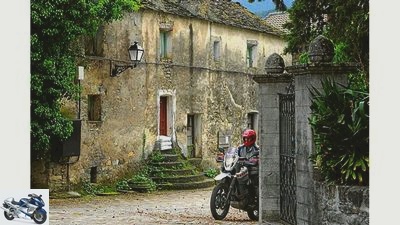
Deleker
10/14
Javierre is one of the old villages in the valley of the Rio Ara, to which life is slowly returning, but which still exude this delightful, morbid atmosphere.
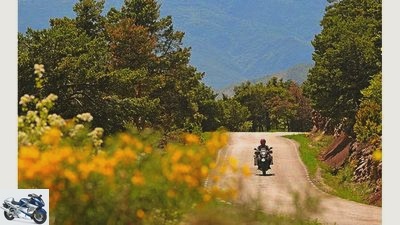
Deleker
11/14
Not uncommon: empty streets.
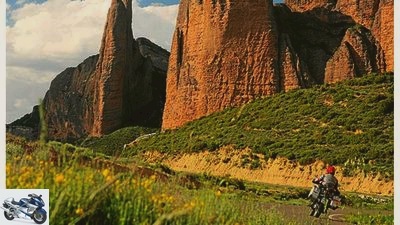
Deleker
12/14
Solitude, tranquility: only the driver, the motorcycle, nature.
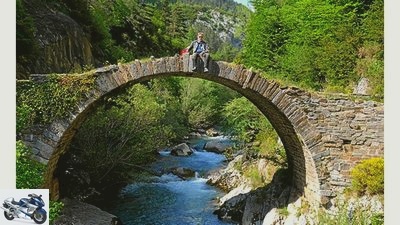
Deleker
13/14
In the loneliness of the Spanish Pyrenees there are ancient bridges that still hold up.
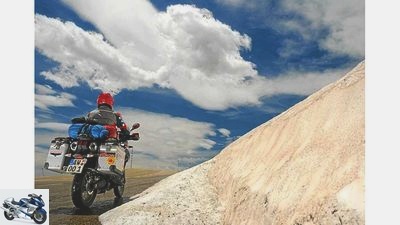
Deleker
14/14
Old snow fields are located at the top of the Puerto de la Pobla pass.
to travel
On the way: Pyrenees
On the way: Cross the Pyrenees by motorcycle
Exploring the French and Spanish Pyrenees
The Spanish Pyrenees are very different from their French counterparts: more exciting, lonely, surprising and wilder. A high mountain cruise between two seas.
Joachim Deleker
October 27, 2011
There are not many areas in Europe where the distance from the sea to the desert is so short. Hardly two hours have passed since I showed the Tenere’s taillight to the Atlantic at Cabo Higuer and headed for Zaragoza through the lush green hills of the Basque Country. And now, a handful of kilometers east of Arguedas, the narrow tarred road crumbles into a stony dusty dirt road that aims straight into the desert. Bárdenas Reales, a bone-dry area in the rain shadow of the Pyrenees, furrowed by waterless barrancos, garnished with bizarre eroded mountains in all pastel colors between white, red and brown. A wondrous scenery that tastes powerfully of freedom, space and adventure.
A long plume of dust swirls behind the XT, which I drive northwards over the uneven slope. Gradually the desert remains, isolated wheat fields, poor meadows and a few sheep appear. In the last light of the day I reach Ruesta at the Yesa reservoir, follow the small sign “Albergue”. Elena, the duty manager, has another gazpacho soup for me. And an unusual place for a tent: right next to the ruins of the old village. And it tells of the long history of Ruesta. In the eleventh century, the Moors built the mighty Castello. The prosperous place arose in its protection. Centuries passed before dictator Franco evicted the village and left it to decay in the 1960s. Today Ruesta is a reconstruction project. Two houses have been perfectly restored, but everything else is in acute danger of collapsing. At least there is life again between the ruins, the Boom on the Camino de Santiago is bringing pilgrims to the rustic inn.
Buy complete article
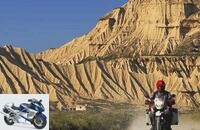
On the way: Cross the Pyrenees by motorcycle
Exploring the French and Spanish Pyrenees
10 pages) as PDF
€ 2.00
Buy now
The Pyrenees begin north of Ruesta. Small, lonely roads line up with the mountains and are almost free of traffic outside of the summer season. An ideal area for – depending on your taste – relaxed or tough motorcycle hiking. Bilingual signs, Basque and Spanish, make it easier to navigate between sparkling clean places and lead me to the “Foz de Arbayún”, the famous gorge near Lumbier. The Rio Salazar has been modeling this canyon with its vertical white limestone walls for a while. Griffon vultures circling silently over the gorge in the morning’s thermals. A place to be amazed.
I follow the Rio Salazar upstream to the border pass Puerto de Larrau, swing 1200 meters down into the French Vallee de Soule and drive the XT over the small lane back up to the Col de la Pierre St. Martin. The view from up there could fill a break if it weren’t for mighty dark clouds from the north, from which jagged lightning flashes. Let’s get out of here. Apparently I’ve had a high-speed thunderstorm behind me. Although the Tenere is by no means slow, I can hardly hang the black wall. Only in the valley of the Rio Aragón do I escape the threatening spectacle, but jet on to Riglos on the Rio Gállego.
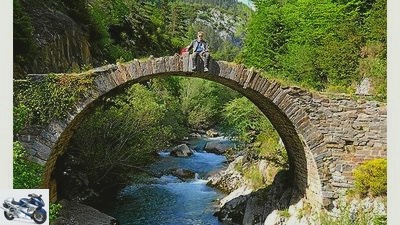
Deleker
In the loneliness of the Spanish Pyrenees there are ancient bridges that still hold up.
Directly behind the white houses, the Mallos de Riglos rise up into the finally blue sky. Fantastic red and yellow rock towers, vertical, huge and bizarre, a paradise for climbers and photographers – and yet hardly known. Not even the travel guide mentions these mountains.
The heart of the Spanish Pyrenees, the Ordesa National Park, is quite different. In summer even the access road from Torla is only accessible by shuttle bus. Fortunately, I’m spared that, I’m allowed to roll into the narrow Ordesa valley on my own wheels. An impressive gorge, shaped by Ice Age glaciers and framed by mighty mountains. Nevertheless, the true charm of the valley remains hidden from me, for that I would have to boot uphill for a few hours on the banks of the Rio Arazas. I confess that I am currently lazy, turn the Yamaha around and prefer to climb up to the viewpoint high above the Garganta de Añisclo. 1200 meter high vertical walls narrow the most famous canyon in the Pyrenees. Far above, the three snow-covered peaks of Monte Perdido bore into the sky. A monumental mountain world, ennobled by UNESCO as a World Heritage Site.
The neighboring canyon of the Rio Vellos is at least as exciting. It takes me three hours for the barely 15 kilometers in Desfiladero de Vellos. Which is not because I push the XT, but because there is just so much to marvel at. The impressions change every second. Fine curtains of water fall from the overhanging rock walls onto the single-lane road. Sometimes the gorge narrows to such a narrow incision that the sky can hardly be seen. Meter-long stalactites grow in limestone caves along the way.
Just a few gaps further, the valley of the Rio Ara is of a completely different character, one of the most beautiful landscapes in northern Aragón. Poplars line the banks, poppies and wheat fields glow in the backlight against black mountains. And again and again ghost villages that testify to the rural exodus of the last century. The young people no longer wanted the barren life of the old and moved to the big cities. The fate of many villages was sealed. Almost every second place in High Aragón is abandoned and in ruins today. After all, this trend has stopped, tourism brings a little money and hope, some old houses have been restored. Like in Javierre, a tiny place between life and death, morbid but full of atmosphere.
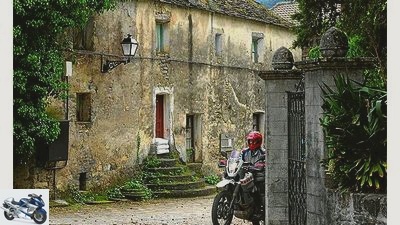
Deleker
Javierre is one of the old villages in the valley of the Rio Ara, to which life is slowly returning, but which still exude this delightful, morbid atmosphere.
Javierre is on National Road 260, the Pyrenees lifeline that begins on the Mediterranean Sea and is always within sight of the mountains to the west. The low-traffic N260 had to suffer mightily from the building craze of the last 20 years, billions of euros of EU funds were not only buried here in extremely questionable expressway projects. Where the N260 is still in its original condition, it is just plain fun, until the good, winding road suddenly stops meandering and breaks straight across bridges, through tunnels and regardless of the landscape.
Fortunately, most of the side streets have been spared the building frenzy. When I turn onto the C1412 in Tremp, one of the most exciting stages in Catalonia lies ahead of me. Over the passes Bóixols and Jou along the Serra de Cadi. Best tar, an endorphin-promoting route that first scares the fearful nipples and then kills them, zero traffic and endless views over the heat-shimmering plains in the south. Every now and then small villages with smoky bars, who cares about the smoking ban? A quick cafe cortado, a few tapas – and on. La Seu d‘Urgell, a piece of N260 to relax, then the great passes Toses and Merolla. 300 kilometers of pure enjoyment.
Should I turn back? Drive again? A tempting thought, but the Mediterranean is now so close that I can almost smell it. Only an hour to go to the easternmost point of the Iberian Peninsula, the Cap de Creus. The photogenic white lighthouse high on the cliffs marks the end of the Spanish Pyrenees. It’s a shame that I don’t have any more time, otherwise I would actually turn around and drive back to the Atlantic. There is still so much to discover.
Travel info
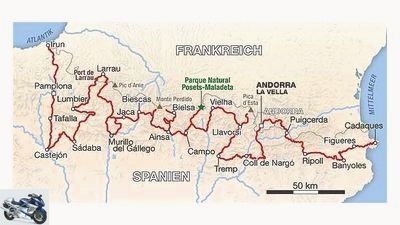
archive
Travel time: 5 days. Distance covered: 520 kilometers.
It’s good that the Pyrenees are not on our doorstep. Otherwise it would be just as crowded there as in the Alps. But above all the Spanish side of the 450 km long high mountains between the Mediterranean and the Atlantic surprises with loneliness, vastness, dramatic landscapes and great curves.
Getting there:
From Cologne to the Spanish border there are at least 1,300 kilometers of toll French motorways. Traveling by car train, which runs once or twice a week from various German train stations to Narbonne in southern France, is less stressful and more convenient. A one-way trip from Dusseldorf costs from 246 euros per person and motorcycle, depending on the season. Information from DB Autozug, phone 0 18 05/24 12 24 or at www.dbautozug.de
Travel time:
On the north side of the mountains it rains about 2000 millimeters per year, on the south side only about 500 millimeters. All passes are open on June 1st at the latest. Ideal travel months are June, September and October. In July and August it can get over 35 degrees in the lower regions. In addition, August is the main travel month, which creates a bit of a hustle and bustle even in the loneliness of the Spanish Pyrenees.
Accommodation:
Especially away from the few tourist centers, it is not easy to find accommodation in the off-season. Some guest houses and campsites do not open until the beginning of June. In the lonely Spanish inland there are often beautiful places to camp freely. A special motorcycle hotel is the Casa Holly near Figueres, which can be used to extend the motorcycle season. Information by phone 0034/9 72 53 56 96 or www.casa-holly.de
Literature:
The selection of travel guides is surprisingly small. We recommend the Pyrenees manual from Reise Know-How Verlag for 23.90 euros. A useful, inexpensive travel companion is the book “Lust auf Pyrenees” from the highlights publishing house Euskirchen. Ten interesting tour suggestions lead through the mountains on around 100 pages. Price 11.90 euros. The sheet “Pyrenees with Andorra” from Reise Know-How Verlag has proven to be a largely reliable map. Scale 1: 250000, price 8.90 euros. The Michelin map 574 on a scale of 1: 400,000 is also highly recommended.
Info:
A lot of information about and about the Pyrenees can be found on the Internet, for example at:
www.pyrenaeen.com
www.parc-pyrenees.com
www.lespyrenees.net
www.pyreneesguide.com
Related articles
-
Motorcycle trip in the Pyrenees
shepherd 33 pictures shepherd 1/33 Motorcycle trip in the Pyrenees – From the Mediterranean to the Atlantic. shepherd 2/33 Air sovereignty: Giant…
-
Route guide: The best passes in the Pyrenees
shepherd 25th pictures shepherd 1/25 The routes on the Spanish side are often better developed, while the French side is more winding and adventurous….
-
With the “Tatort” author and Triumph scrambling through the Pyrenees
Frill to travel With the &# 34; crime scene&# 34; author and Triumph scrambler through the Pyrenees Offroad through the Pyrenees With the “crime…
-
On the move: Spain from north to south
Deleker 15th pictures Deleker 1/15 With the motorcycle across Spain, a trip with many highlights. Deleker 2/15 Ready for a movie: Spain’s castles are…
-
to travel On the way Croatia On the way Croatia Mission island hopping Few countries are as rich in islands as Croatia: there are 1185 islands, only 67…
-
Out and about in Greece: motorcycle tour
Deleker 16 pictures Deleker 1/16 Dream beach: Porto Katsiki on the Ionian Sea. Deleker 2/16 At 600 years old, the Von Kipi Bridge is still young. Deleker…
-
to travel Morocco Morocco So close – so strange An enduro tour through the bitter Atlas Mountains takes you into the magical and strange world of the…
-
to travel Slovenia Slovenia In all silence The charm of Slovenia is only revealed on side roads, the smallest streets and gravel roads. And the best…
-
to travel Bulgaria Bulgaria Southeast course Bulgaria – cheap travel destination? A transit country in south-east Europe on the way to Turkey? True, but…
-
Motorcycle tour Vorarlberg – out and about in Montafon
Luthardt to travel Motorcycle tour Vorarlberg – out and about in Montafon Motorcycle tour Vorarlberg Out and about in Montafon A trip to the west of…